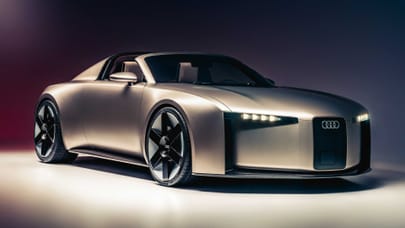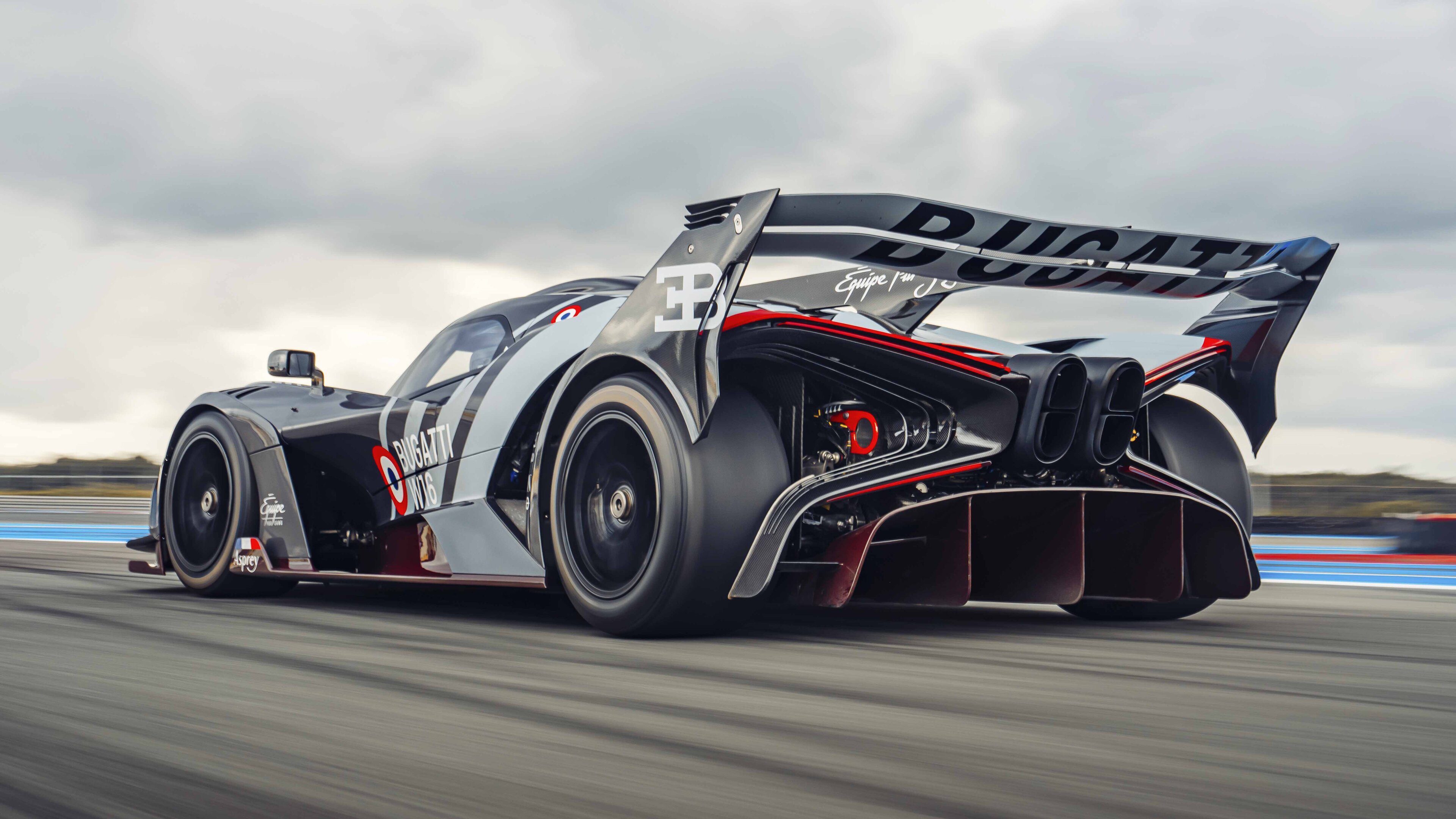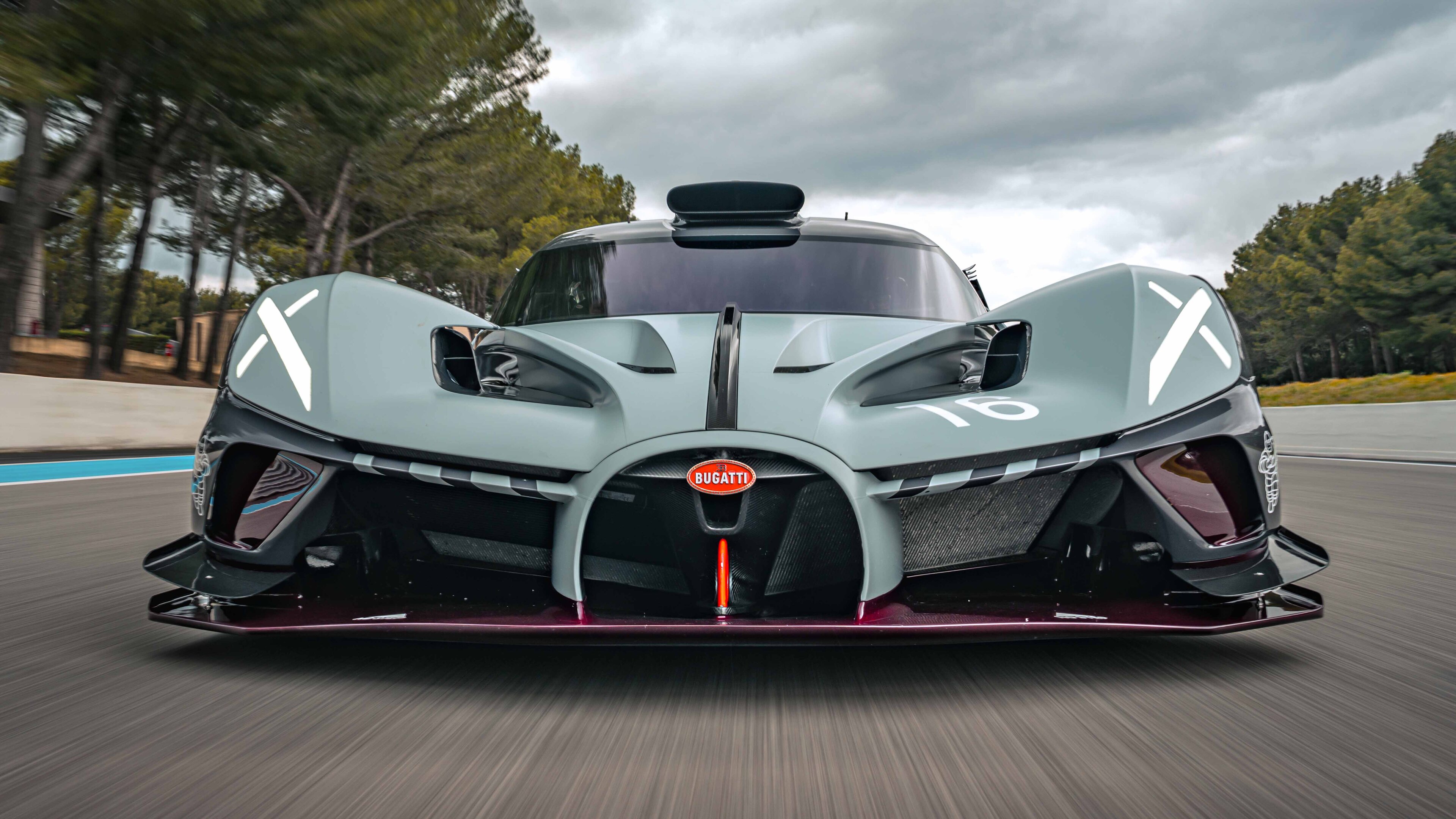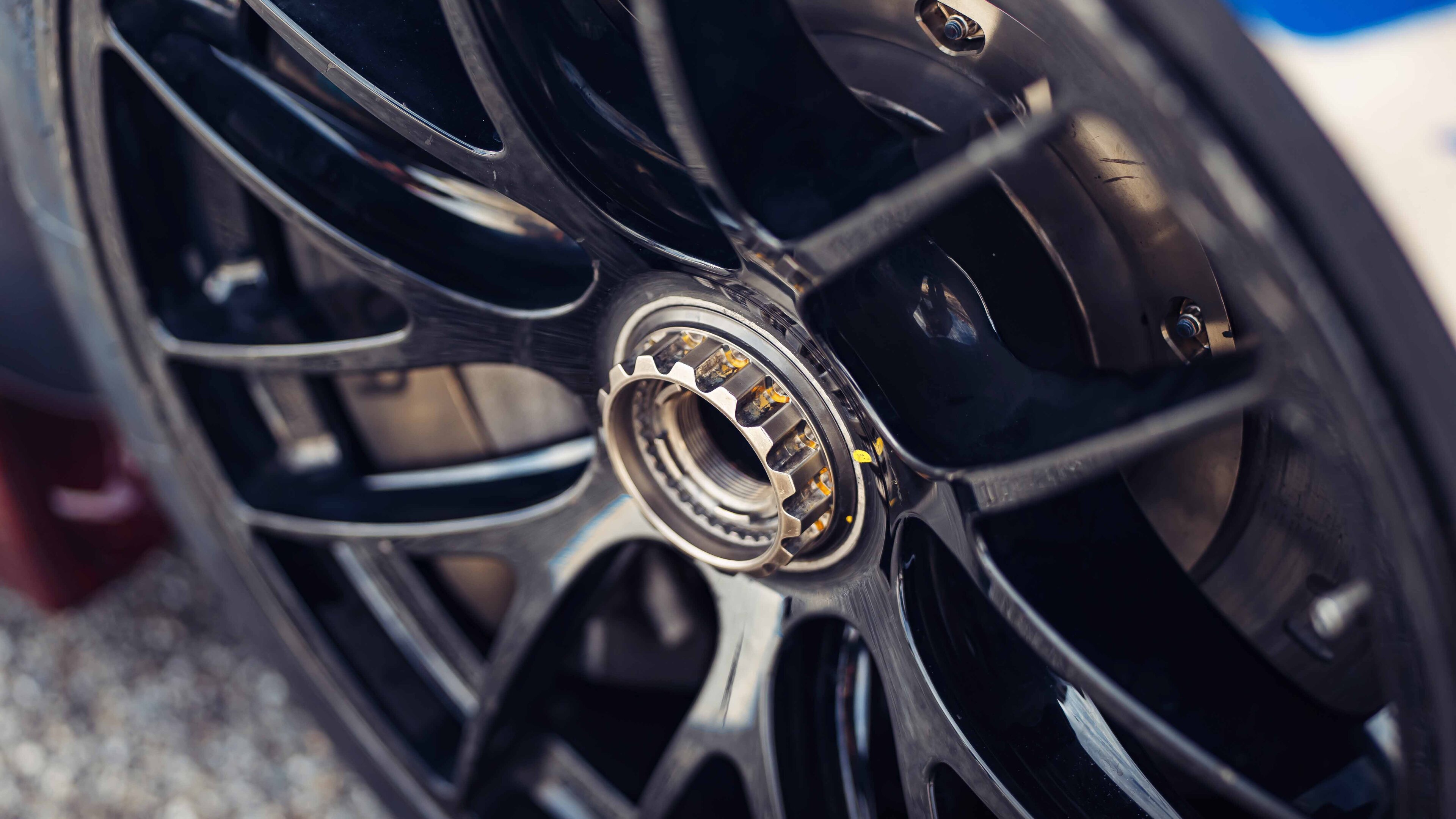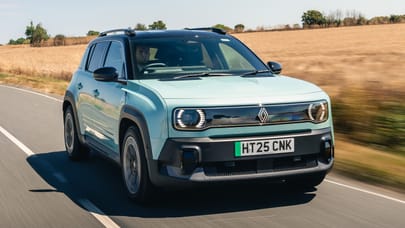
The 'king of engines': one last hurrah in the 8.0-litre, 1,578bhp Bugatti Bolide
The quad turbo W16 gets a final, intense flourish in the lightweight, track only, multimillion pound Bolide. TG hangs on tight
The king of engines whoomphs into life. Definitely whoomphs. It doesn’t snarl or scream, it doesn’t pepper the air with fake pops, there’s just a sense of a lot of air being drawn in, and then suddenly combusted deep inside. Whoomph.
This is not a new noise. It’s the sound Bugatti’s W16 has always made and there’s nothing else like it because no one else has ever had a W16. The king of engines doesn’t need to be rowdy. It communicates in another way. It’s the only engine I’ve come across that uses the ground underneath it as a resonating surface, sending vibrations far and wide, like how a croc ripples its back in the water. You’d probably read it as a warning not to mess, and that wouldn’t be a bad interpretation. Even now it’s unsilenced and decatalysed, it’s not so much noise that it emits as presence.
The bodywork? That makes a tad more fuss. From the sinewy snout along the raked profile to the X-wing rear end, it exudes menace. A wheeled knuckle duster, the king of engines dressed as a street fighter.
Photography: Mark Riccioni
The Bolide is the most extreme Bugatti there’s ever been. It’s more powerful than any racing car, has to shed more energy in the course of a lap, delivers 2,900kg of downforce, 2.5g of cornering force, explosive acceleration force – in short it’s one of the most forceful cars there’s ever been. And it is the last place a W16 engine will ever call home. Now 20 years old, we’ll miss it when it’s gone. Other hypercar engines rev higher, shriek louder. One or two produce more power, several are more power dense, all are smaller, lighter. But just as you don’t doubt the lion’s claim to be king, nor do you question the W16’s. All others live in its shadow.
You’d imagine quite a lot has had to be done to the quad turbo 8.0-litre for this track only version, what with all the forces it’s got to deal with. Nah. It’s not the engine that’s had to be changed. It’s the car. Because Bugatti has done something remarkable here. It’s built a car that can cope.
The engine itself is pretty much as it came out of a Chiron Super Sport. Same internals, same valvetrain, pistons and conrods, even the same oil and water pumps. But how do you take a 1,578bhp, 1,179lb ft powerplant, that together with its (only lightly modified) twin clutch transmission is a leviathan weighing some 700kg, and build a track car around it?
Well, you don’t start with a Chiron. Dallara built Bugatti a bespoke carbon tub to Le Mans Hypercar regulations, and from there Bugatti set about creating a car that would showcase the engine in its purest form. Because that’s what’s going on here. This is not a track car that happens to be powered by a W16, it’s a W16 given a new dimension on track. That’s a small but important distinction.
Top Gear
Newsletter
Thank you for subscribing to our newsletter. Look out for your regular round-up of news, reviews and offers in your inbox.
Get all the latest news, reviews and exclusives, direct to your inbox.
I’m at Paul Ricard in the south of France. Tomorrow four owners are turning up to drive their new cars. Today is the training day for the instructors who will sit alongside them (no thanks) and Bugatti has found a small gap for me to drive it as well. It’s a busy day. Some 40 people mill around. Big boss and CEO Mate Rimac is here, so too most of Bugatti’s board of directors. I spend the morning in track briefings, filling out terrifying paperwork and watching the Bolide thunder around.
Bugatti has laid on a pair of GT3 RSes as track learning cars. I’m watching them howl down the main straight when I sense another movement. The Bolide is storming out of the final corner. It devours the distance to the hard charging Porsches in great chunks, rips past them under the gantry. The speed differential is colossal, but more than that there’s just this sense of immense pent up aggression being released.
I think about this an hour or so later as I’m strapped into the Bolide. It’s tight in here, the wheel butting up close to the A-pillar, the view out blinkered by high front arches. The 3D printed steering yoke is reassuringly solid in my hands – just as well given how hard I’m clenching it. Raindrops have just started to pepper the windscreen. I’m on slicks. Andy Wallace has the good grace not to look remotely concerned as he straps in alongside me.
“Once you’ve got the pit speed on, just put the throttle wide open and hold it there.”
“In first gear?” I reply bemusedly.
“Yep, in first. And then at the end of the pitlane, knock the limiter off and hold on tight.”
I point blank refuse. “No way. It’ll spin all four wheels and I’ll be straight into the barriers.”
“Honestly. As long as it’s got good tyre temperature, it’ll hook up without a trace of wheel slip.”
Whoomph. The king of engines fires. I immediately resolve not to do as I’m told, given the engine appears to be clawing its way through the bulkhead. The Bolide throbs and pulses with barely contained energy. I wincingly click the paddle for first gear, gingerly touch the throttle and the Bolide crawls away, docile as anything. I pull second. Barely sense the shift. Chiron vibes.
And so, once clear of the pitlane, I nail it. My world erupts. Noise. Force. Power. All of it huge. It’s all consuming, a furious, unrelenting onslaught. I brake for the first corner. There’s little heat in the brakes so they surf on. Ooh gawd. Then I turn in and the Bolide starts to slide. Gulp. Don’t forget it’s damp, Marriage. It slides through turn three. And four. And five. Bloody hell.
But by the end of the lap I don’t want to park up, I just want more. Because the Bolide moves so well. Yes it slid, but a) that was entirely my fault for getting carried away on cold tyres and a damp track, b) it was caught masterfully by the life – and reputation – saving stability control, and c) the reason I was happy pushing immediately was that the Bolide felt calm in my hands, not snatchy, but progressive.
The handling takes its lead from the motor, which delivers its power with creamy smoothness across the whole rev range. There’s no top end crescendo, just this outrageous thrust everywhere, accompanied by monstrous bass roar. It’s not sharp and zingy, the king of engines likes the power to be poured on and kept on, not fiddled with mid corner.
And the dynamics are the same. When I speak to Mate Rimac afterwards he’ll tell me, “Ultimately it’s not about lap times in this car, it needs to be engaging for our customers to drive. And many of them are not racers.” He goes on to admit that some of them aren’t even likely to drive the car at all. I understand the ‘wheeled artwork’ argument sometimes, but not here, not with this.
So despite the way it looks, it’s friendly, benign, approachable. There’s nothing tricksy about it. The steering rack is fast but not Ferrari twitchy. There’s not much actual steering feedback but it’s positive and incisive into corners and there’s loads of feel through the seat. The chassis is a great communicator. Hadn’t expected that.
But the best bit happens after the apex. And it’s not just because you get to shovel air and 102 octane fuel into the power station. It’s how all four wheels deal with the resulting torque onslaught. Because the diffs are sensational at putting the power exactly where it’s needed to maximise traction without spoiling trajectory. It’s just wonderfully flattering, makes me feel like a hero as it exits slow corners with a whiff of four wheel drift.
The twin clutch box has new ratios and final drive, better suited to sprinting up to the 236mph max. Downforce at that speed hits 2,900kg. Once into sixth at, what, 170-odd mph, I notice the acceleration let up a fraction as drag takes effect. And then there are the brakes. Early suggestions of a 1,250kg kerbweight came to naught – the Bolide is probably around 1,625kg with fluids and me on board.
Yet the power means it arrives into braking zones at outrageous speeds, a kinetic energy conundrum that Brembo has solved with 390mm carbon carbon brakes that apparently feature F1 materials. And ABS. A rare, perhaps unique, combo. They’re foolproof and the stopping power hangs me in the belts every time. Ever skydived? That breath crushing feeling when the parachute is yanked? It’s that. Every corner. Mega pedal feel – I see operating temperatures up over 800ºC and those outside get glowing discs.
I’m swatted down the track like a suddenly flattened fly. I hoot with laughter
If there’s an issue here it’s the load all of this places on the tyres. Due to high speed aero load, Michelin insists on high pressures – around 35–38psi. They’re fine there, but Wallace says grip drops away significantly when they go above that.
The long and the short of all this is that the Bolide is very harmonious. The king of engines has been matched in braking power, lateral grip, and yes, traction. On my last lap I slow down on the back straight and engage the pit limiter. It sits smoothly at 40mph in first gear and I hold it there for five seconds to let the four turbos pressurise. And then I thumb the little black button on the steering wheel to cut loose the king of engines and I’m swatted down the track like a suddenly flattened fly. I hoot with laughter, while blown away that the slicks can cope with every single one of the 1,600-odd horses without so much as a chirrup. Andy reckons it’s even more vivid than launch control from a standstill. I can believe him.
Like I said, the Bolide feels very together, each component balanced against the others. I remember thinking the same after I drove another track only hypercar – McLaren’s P1 GTR. The whole car is calm under pressure – and more than that it feels like a Bugatti. When I track down Mate afterwards he tells me “the hardest thing for this project was to make it a Bugatti in terms of detail and quality. Racecars are fascinating things, but they’re not Bugattis". I’d expected to find the Bolide a racecar with a W16 shoved in. With only 40 being built I thought it would be heavily compromised, a bit of a Frankenstein’s monster.
But as Mate said, if that were the case, it wouldn’t be a Bugatti. Instead the Bolide seems to have been as rigorously developed as a Chiron by people with a very clear idea of who it’s for and what it needs to do. Ballistically fast, yes, but also polished and flattering, which gives the driver the mental capacity to enjoy and appreciate the Bolide’s centrepiece, the 16 pulsating pistons and conrods, four turbos and 64 valves that make up the world’s one and only W16 engine. The king of engines.
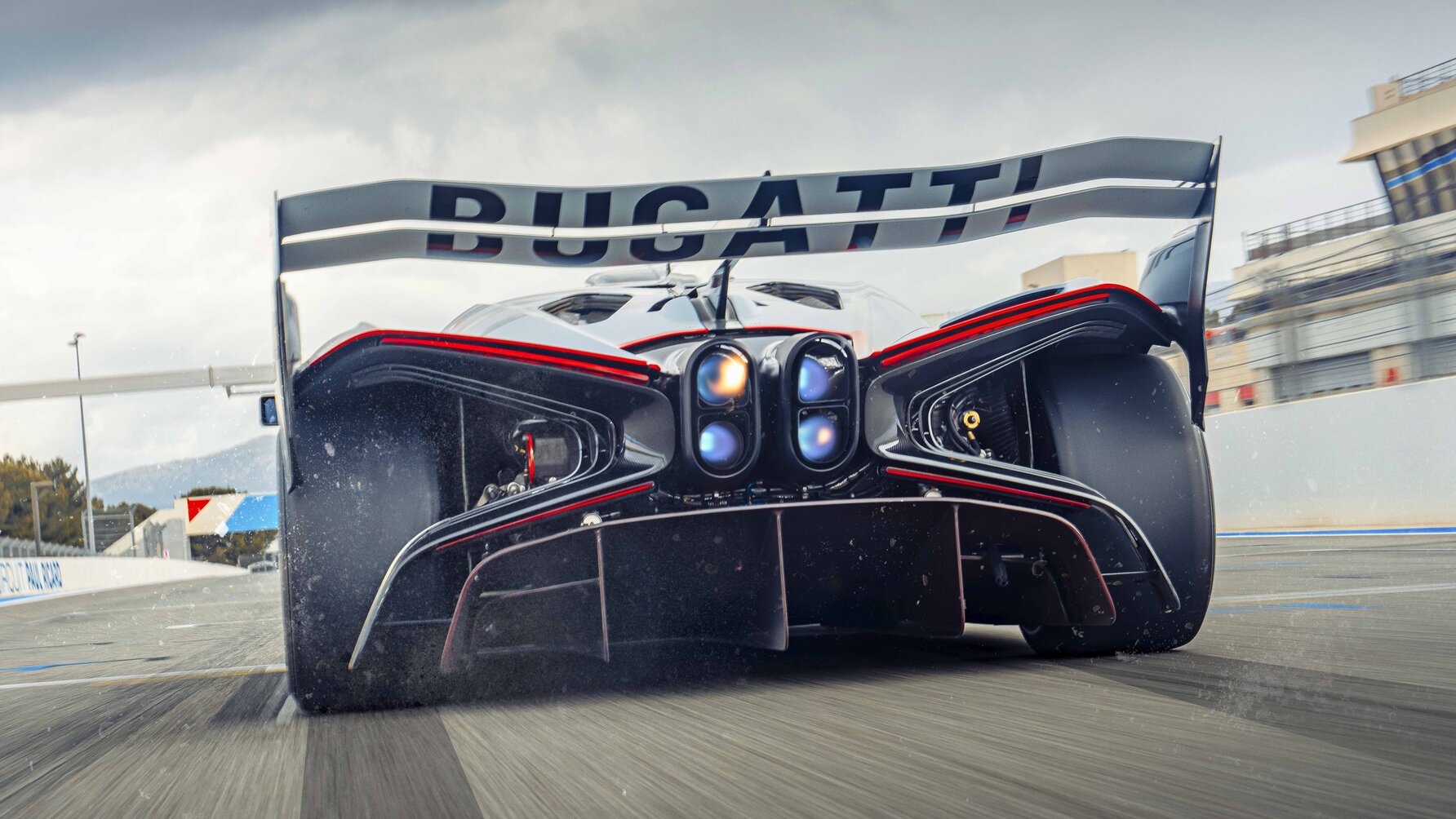
Trending this week
- Car Review
BMW iX3







